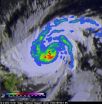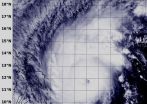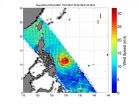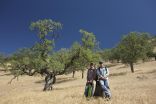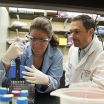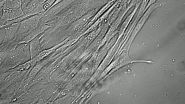(Press-News.org) Super Typhoon Hagupit is forecast to make landfall in the eastern Philippines bringing heavy rainfall, damaging winds and storm surge. NASA/JAXA's TRMM satellite and the RapidScat instrument provided rainfall and wind data, while NASA-NOAA's Suomi NPP satellite provided a visible image of the storm. In the Philippines, Hagupit is known locally as "Typhoon Ruby."
The Tropical Rainfall Measuring Mission or TRMM satellite caught a good view of Super Typhoon Hagupit on December 4, 2014 at 1721 UTC (12:21 p.m. EST) when its sustained winds were estimated at over 145 knots (166.8 mph). TRMM's Microwave Imager (TMI) showed that the heaviest rainfall was just southwest of a well-defined eye.
About three hours later the International Space Station-RapidScat instrument captured data on Hagupit's winds. The RapidScat image showed sustained winds of at least 30 meters per second (67 mph/108 kph) around the eye of the storm.
NASA-NOAA's Suomi NPP satellite flew over Super Typhoon Hagupit on Dec. 5 at 4:22 UTC (Dec. 4 at 11:22 p.m. EDT) and the Visible Infrared Imaging Radiometer Suite or VIIRS instrument aboard captured a visible image of the storm. The VIIRS image showed a symmetric ring of intense thunderstorms surrounding the 12-nautical-mile-wide eye.
VIIRS is a scanning radiometer that collects visible and infrared imagery and "radiometric" measurements. Basically it means that VIIRS data is used to measure cloud and aerosol properties, ocean color, sea and land surface temperature, ice motion and temperature, fires, and Earth's albedo (reflected light).
At 1500 UTC (10 a.m. EST) on Dec. 5, Super Typhoon Hagupit's maximum sustained winds were near 130 knots (149.6 mph/241 kph), down from 150 knots (172 mph/277.8 kph). Typhoon-force winds extend out 40 nautical miles (46 miles/74 km) from the center, while tropical-storm-force winds extend out to 120 miles (138 miles/222 km).
Hagupit was centered near 12.1 north longitude and 128.2 east latitude, about 465 nautical miles (535 miles/861 km) southeast of Manila, Philippines. Hagupit continued moving in a west-northwesterly direction. The storm is generating very rough and dangerous seas with wave heights to 45 feet (13.7 meter).
According to the Joint Typhoon Warning Center (JTWC) forecast, Super Typhoon Hagupit will "maintain intensity until it starts interacting with land near 24 hours (1500 UTC/10 a.m. EST on Dec. 6) then the system will begin rapidly weakening."
Many warnings are in effect throughout the Philippines. Public storm warning signal #2 is in effect in the following provinces: Visayas: Northern and eastern Samar, Samar, Biliran, Leyte, southern Leyte, northern Cebu and Cebu City, Bantayan Island and Camotes Island. In Luzon, signal #2 is in effect for: Albay, Sorsogon, Ticao Island and Masbate.
Public storm warning signal #1 is in effect in the Province of Visayas including: Capiz, Iloilo, Antique, Guimaras, Aklan, Negros Oriental & Occidental, rest of Cebu, Siquijor and Bohol. Signal #1 is also in effect in the Mindanao Province for Surigao del Sur, & Norte, Misamis Oriental, Agusan del Sur & Norte, Dinagat Island and Camiguin Island; and in the Province of Luzon, including: Catanduanes, Camarines Norte & Sur, Burias Island and Romblon.
On Dec. 5 at 10 a.m. EST (1500 UTC) the latest update from the Philippine Atmospheric, Geophysical and Astronomical Services Administration known as PAGASA called for expected landfall on Saturday evening (Dec. 6) or Sunday morning (Dec. 7) over the Eastern Samar - Northern Samar area and it will be associated with strong winds, storm surge (up to 4 meters) and heavy-intense rainfall.
PAGASA noted:
"Estimated rainfall amount is from 7.5 - 20 mm per hour (heavy - intense) within the 600 km diameter of the typhoon.
Ruby (Hagupit) and the Northeast Monsoon will bring rough to very rough sea conditions over the seaboards of Northern Luzon, eastern seaboard of Central and Southern Luzon, seaboards of Visayas and over northern and eastern seaboards of Mindanao. Fishermen and those using small seacraft are advised not to venture out over the said seaboards."
INFORMATION:
For more information and updates visit: http://www.pagasa.dost.gov.ph or http://meteopilipinas.gov.ph/map.php.
Hagupit is tracking generally westward along the southwestern edge of a subtropical ridge (elongated area) of high pressure which is located south of Japan. Over the next three days, Hagupit is forecast to track west to west-northwest under the influence of that area of high pressure.
Rob Gutro
NASA's Goddard Space Flight Center
ABBOTT PARK, Ill., Dec. 4, 2014 - Even in food-abundant industrialized countries like the U.S., an alarming number of people, particularly seniors, are in a state of diseased-associated malnutrition . Because of the impact on patient health, disease-associated malnutrition imposes a significant economic burden on society of $157 billion per year, according to new research published in a supplemental issue of the Journal of Parenteral and Enteral Nutrition (JPEN) and supported by Abbott .
Researchers looked at malnutrition across eight specific diseases* and evaluated ...
(Salt Lake City) --How can people who are dependent on prescription opioids reduce their cravings? Learn to enjoy other aspects of their lives.
That's the key finding in a new study published in the Journal of Behavioral Medicine by Eric L. Garland, associate professor at the University of Utah College of Social Work. Garland and colleagues studied how an intervention program for chronic pain patients called Mindfulness-Oriented Recovery Enhancement (MORE) decreased patients' desire for prescription drugs.
The MORE intervention concentrates on helping people ...
As California finally experiences the arrival of a rain-bearing Pineapple Express this week, two climate scientists from the University of Minnesota and Woods Hole Oceanographic Institution have shown that the drought of 2012-2014 has been the worst in 1,200 years.
Daniel Griffin, an assistant professor in the Department of Geography, Environment and Society at the University of Minnesota, and Kevin Anchukaitis, an assistant scientist at Woods Hole Oceanographic Institution, asked the question, "How unusual is the ongoing California drought?" Watching the severity of ...
Genetic mutations may cause more cases of amyotrophic lateral sclerosis (ALS) than scientists previously had realized, according to researchers at Washington University School of Medicine in St. Louis and Cedars-Sinai Medical Center in Los Angeles. The scientists also showed that the number of mutated genes influences the age when the fatal paralyzing disorder first appears.
ALS, also known as Lou Gehrig's disease, destroys the nerve cells that control muscles, leading to loss of mobility, difficulty breathing and swallowing, and eventually paralysis and death. Understanding ...
The Institute for Quality and Efficiency in Health Care (IQWiG) investigated in a dossier assessment whether propranolol offers an added benefit in comparison with the appropriate comparator therapy in infants with proliferating infantile haemangioma (sometimes called "strawberry mark").
According to the findings, there is an indication of major added benefit of propranolol in some children, i.e. those with haemangioma with a risk of permanent scars or disfigurement. In contrast, an added benefit is not proven for children with life- or function-threatening haemangioma, ...
The vicious cycle of diabetes describes a scenario where people are becoming fatter, often with elevated levels of glucose, and at increased risk for women to develop gestational diabetes (GDM). Intrauterine exposure to GDM, itself, is a major risk factor for later obesity and diabetes, thus perpetuating this maternal-offspring cycle of disease.
Researchers from Lund University have published an overview of evidence across the past few decades in the journal Diabetes, Metabolic Syndrome and Obesity: Targets and Therapy. They emphasize the need to update diabetes prevention ...
It means cancer "in place" but a carcinoma "in situ" often does not want to keep its place. Standing between a cancer cell in situ and the surrounding tissue of fibroblasts and extracellular matrix is the basement membrane, a thin sheet of fibers that normally cradles the cells above it. The basement membrane is also the frontline physical barrier that keeps primary tumors from spreading into the matrix below. Perforating the basement membrane is a cancer cell's first move toward invasion, but how? Fibroblasts are most commonly found in connective tissue that synthesizes ...
In the human brain, the BBB is not the Better Business Bureau but the blood brain barrier and the BBB is serious business in human physiology. The human BBB separates circulating blood from the central nervous system, thus protecting the brain from many infections and toxins. But the BBB also blocks the passage of many potentially useful drugs to the brain and it has long stymied scientists who want to learn more about this vital tissue because of the lack of realistic non-human lab models. Even less is known about the BBB in children. There are significant structural and ...
VIDEO:
This 19-second time lapse video shows the first six hours of neuronal conversion of skin fibroblasts from a patient with Alzheimer's disease.
Click here for more information.
The search for a living laboratory model of human neurons in the grip of Alzheimer's disease (AD)--the so-called "Alzheimer's in a dish"--has a new candidate. In work presented at the ASCB/IFCB meeting in Philadelphia, Håkan Toresson and colleagues at Lund University in Sweden report success ...
Location, location, location goes the old real estate proverb but cancer also responds to its neighborhood, particularly in the physical surroundings of bone marrow cells where human myeloid leukemias arise and where, according to two Harvard bioengineers, stiffness in the surrounding extracellular matrix (ECM) can predict how cancer subtypes react to chemotherapy. Correcting for the matrix effect could give oncologists a new tool for matching drugs to patients, the researchers say.
In work to be presented at the ASCB/IFCB meeting in Philadelphia, Jae-Won Shin and David ...
